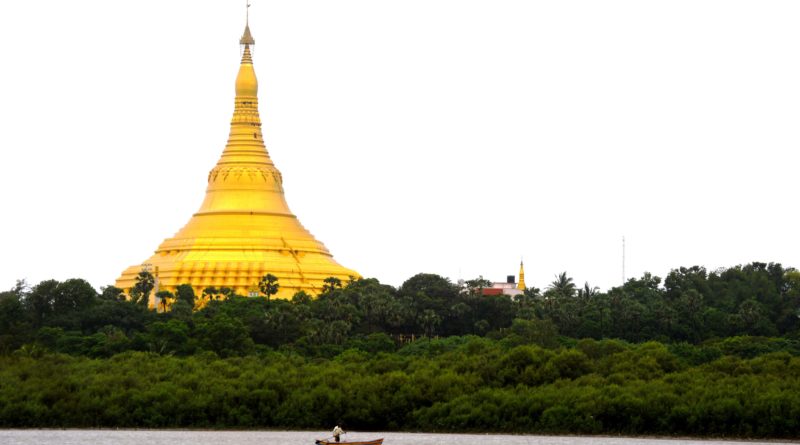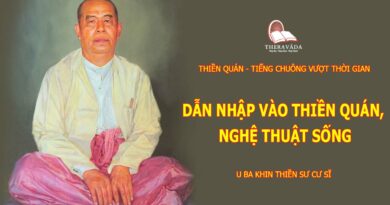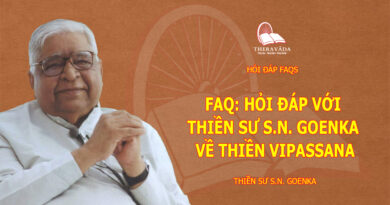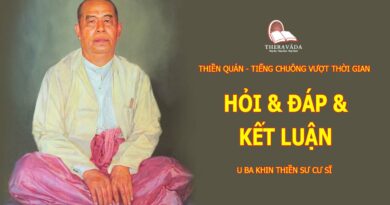Nội Dung Chính
Spread of Vipassana in Modern Times – Sự lan tỏa của Vipassana trong thời đại mới
Initial Vipassana Centers – Các trung tâm Vipassana ban đầu
After conducting numerous Vipassana courses on rented sites since 1969, some of the old students decided to establish permanent Vipassana centers to provide a better atmosphere of practice for students. After thorough search, the land near Igatpuri was finalized and after millennia, the priceless jewel of Dhamma found a casket — Dhamma Giri. This Center was followed by two other centers in Hyderabad and Jaipur. Today there are Vipassana Centers all around the world. Read more…
Sau khi thực hiện vô số khóa thiền Vipassana tại các địa điểm thuê mướn từ năm 1969, một vài thiền sinh cũ đã quyết định thành lập các trung tâm Vipassana cố định để cung cấp môi trường tốt hơn cho các thiền sinh hành thiền. Sau nhiều cuộc tìm kiếm, mảnh đất gần Igatpuri được cuối cùng được tìm thấy và sau nhiều thiên niên kỷ, viên ngọc quý vô giá của Dhamma đã tìm thấy chiếc hộp của mình– Dhamma Giri. Trung tâm này được thành lập sau hai trung tâm khác ở Hyderabad và Jaipur. Ngày nay, các trung tâm Vipassana đã có khắp nơi trên thế giới. Đọc thêm.
India/ Ấn Độ
The spread of Vipassana in India has an interesting history. The technique of Vipassana had been re-discovered by the Buddha and preserved in Burma in the teacher-disciple tradition. Goenkaji’s teacher, Sayagyi U Ba Khin, sincerely wanted to pay back Burma’s debt to India by returning the technique of Vipassana meditation to the land of its origin. Circumstances did not permit him to come to India and teach Vipassana himself, but his student Mr. S. N. Goenka, whom he had given thorough training to become a teacher of Vipassana, had the opportunity to do so. After facing initial difficulties, the first Vipassana course was held by Mr. Goenka at Panchayatiwadi, Mumbai in July 1969. Fourteen students participated in this course. The second course was held in the same year at Agarwal Bhavan, Chennai, which was attended by fifteen students. Gradually the numbers began to increase.
Sự lan tỏa của Vipassana tại Ấn Độ là câu chuyện thú vị. Kỹ thuật của Vipassana đã được tìm lại bởi Đức Phật và bảo tồn tại Burma trong truyền thống thầy trò. Thầy của Goenkaji, Ngài Sayagyi U Ba Khin, chân thành muốn trả lại món nợ mà Burma đã nợ Ấn Độ bằng cách mang phương pháp Vipassana trở về quê hương của mình. Hoàn cảnh đã không cho phép chính Ngài ấy đến Ấn Độ để dạy Vipassana, nhưng học trò của Ngài Thầy S.N.Goenka, người đã được Ngài đào tạo trở thành Thiền sư Vipassana, đã có cơ hội thực hiện điều đó. Sau nhiều khó khăn ban đầu, khóa thiền Vipassana đầu tiên được Thầy Goenka tổ chức tại Panchayatiwadi, Mumbai vào tháng Bảy năm 1969. Mười bốn thiền sinh đã tham dự khóa thiền này. Khóa thứ hai được tổ chức vào cùng năm tại Agarwal Bhavan, Chennai, khóa thiền này có mười lăm thiền sinh tham dự. Dần dần số lượng các lượng thiền sinh tăng lên.
Initially there were several difficulties in organizing courses. Those who wanted to organize courses had to arrange for facilities like accommodation and food among other facilities. But people who had derived benefits from Vipassana sincerely wanted others also to have the opportunity to try it and get the benefits. So they did not lose heart. As Goenkaji recalls, “These people derived no material advantage from their work, nor did they expect any, not even name and fame. It was simply because they had benefited from this wonderful technique that they wanted more and more people to benefit”. This had a miraculous effect. Slowly and steadily Vipassana began to spread and people came to know about it by word of mouth. Another important factor that greatly contributed to the spread of Vipassana in the initial days was Goenkaji’s indefatigable zeal to travel the length and breadth of India to introduce Vipassana to the people. Between July 1969 and February 1998, Mr. Goenka conducted more than 425 courses across India.
Ban đầu việc tổ chức khóa thiền gặp nhiều khó khăn. Những người muốn tổ chức khóa thiền phải sắp xếp cơ sở vật chất như chỗ ở và thức ăn ở các cơ sở khác. Nhưng những ai đã nhận được lợi lạc từ Vipassana chân thành muốn người khác cũng có cơ hội nếm trải và đạt lợi lạc. Vì thế họ đã không nản lòng. Như Thầy Goenkaji nhớ lại,”Những người không vị lợi vật chất từ công việc của mình, hoặc không mong cầu điều gì, thậm chí là tên tuổi và danh tiếng. Chỉ đơn giản vì họ đã đạt lợi lạc từ phương pháp tuyệt vời này do đó họ mong muốn càng nhiều người đạt lợi lạc hơn.” Đây là một hiệu ứng diệu kỳ. Chầm chậm và dần dần Vipassana bắt đầu lan tỏa và càng nhiều người biết đến thông qua truyền miệng. Một nhân tố quan trọng khác đã góp phần rất lớn cho việc lan tỏa Vipassana trong những ngày đầu là lòng hăng hái không mệt mỏi của Thầy Goenkaji khi Thầy đã đi chu du khắp chiều dài và chiều rộng của Ấn Độ để giới thiệu Vipassana tới nhiều người. Từ tháng Bảy 1969 và tháng Hai 1998, Thầy Goenka đã thực hiện hơn 425 khóa thiền khắp Ấn Độ.
In a country where the teachings of the Buddha were largely unknown or regarded with distrust, Goenkaji found a way to present the essence of Dhamma. He emphasized the universal nature of human suffering and taught how to overcome it through a process of self-observation, that removes one’s mental impurities, irrespective of a person’s religious or cultural traditions. Over the time, large numbers of people from different religions, ethnic groups and castes started participating in courses. Leaders of various religions joined in too. Leaders of the Hindu Samaj and the Vishwa Hindu Parishad sat courses and encouraged others in their communities to participate. Prominent leaders in the Christian community and many Christian priests and nuns also sat courses. Mother Superior Mary at Dalhousie (H.P.) once told Goenkaji, “You are teaching Christianity in the name of Buddha”. In Kutch, two courses were held in a mosque, where leaders in Muslim communities also attended courses and encouraged many to sit the course. In Northern India and in Nagpur, Buddhist monks and nuns attended courses.One by one, all the communities started to join the courses.
Ở một quốc gia nơi lời dạy của Đức Phật phần lớn không được biết đến hoặc bị cho là không đáng tin, Goenkaji đã tìm cách để trình bày bản chất của Dhamma. Thầy đã nhấn mạnh bản chất phổ quát của nỗi khổ của loài người và dạy cách làm thế nào thoát khổ qua tiến trình tự quan sát, nhằm loại bỏ các bất tịnh trong tâm trí con người, không phân biệt tôn giáo và truyền thống văn hóa của họ. Theo thời gian, nhiều người đến từ các tôn giáo, cộng đồng và đoàn thể khác nhau bắt đầu đến tham dự khóa thiền. Các lãnh tụ của nhiều tôn giáo cũng đã tham dự. Các nhà lãnh đạo của đạo Hindu Samaj và Vishwa Hindu Parishad cũng ngồi các khóa thiền và khuyến khích những người khác trong cộng đồng của họ tham gia.. Những nhà lãnh đạo xuất chúng của cộng đồng Cơ Đốc Giáo và nhiều linh mục Cơ Đốc giáo và masoeur cũng đến ngồi các khóa thiền. Mẹ Trưởng viện Mary tại Dalhousie (H.P) một lần nói với Goenkaji,” Thầy đang dạy Cơ Đốc giáo dưới tên của Đức Phật.”. Ở Kutch, hai khóa thiền được tổ chức ở một thánh đường hồi giáo, nơi các lãnh tụ của cộng đồng Hồi Giáo đã đến tham gia và cũng khuyến khích nhiều người đến ngồi khóa thiền. Ở Phía Bắc Ấn và Nagpur, các tăng Phật giáo và các ni sư cũng tham dự các khóa thiền. Từng chút một, tất cả cộng đồng tôn giáo đã bắt đầu tham gia khóa thiền.
Some of these students decided to establish Vipassana centers at Igatpuri, Hyderabad and Jaipur. They left no stone unturned to create facilities at the centers so that Vipassana courses could be held continuously. The three centers were then followed by setting up a center in Kutch. In this way many centers, one after the other, were established, and at present there are about 80 centers and 13 non-center locations in India that cater to the needs of those who aspire to lead a pure and peaceful life.
Vài thiền sinh trong số đó đã quyết định thành lập các trung tâm Vipassana tại Igatpuri, Hyderabad và Jaipur. Họ đã làm tất cả để tạo dựng các cơ sở vật chất tại các trung tâm do vậy các khóa thiền Vipassana có thể tổ chức liên tục. Tiếp đó có ba trung tâm được lập sau trung tâm tại Kutch. Bằng cách này nhiều trung tâm, trung tâm này đến trung tâm khác được thành lập và hiện tại có khoảng 80 trung tâm chính thức và 13 trung tâm ở các địa điểm không chính thức ở Ấn Độ để đáp ứng nhu cầu của những người mong mỏi bước đến một cuộc sống thanh tịnh và an lạc.
These centers are supported by over 500 teachers and assistant teachers in India, who help Goenkaji’s mission of spreading Dhamma. Vipassana courses are now held regularly at all these centers and at many non-center locations. Thus, Dhamma is growing stronger and stronger in the country of its origin. To read the detailed history of the spread of Dhamma in India, please click here.
Các trung tâm ở Ấn Độ được hỗ trợ bởi 500 thiền sư và thiền sư phụ tá, những người đã giúp đỡ sứ mệnh lan tỏa Dhamma của Goenkaji. Các khóa thiền Vipassana hiện nay được tổ chức thường xuyên tại các trung tâm trên và tại nhiều trung tâm không chính thức. Theo đó, Dhamma ngày càng phát triển mạnh mẽ hơn ở quốc gia nơi Dhamma khởi nguồn. Để đọc lịch sử chi tiết về sự lan tỏa của Dhamma tại Ấn Độ, vui lòng nhấn vào đây.
Current Highlights – Những điểm nhấn hiện nay
Central India: There are total 7 centers in Central India. Two centers are located in Chhattisgarh (Dhamma Garhand Dhamma Ketu) and five centers are located in Madhya Pradesh (Dhamma Kanana, Dhamma Pala, Dhamma Malwa, Dhamma Bala and Dhamma Rata). There is also one non-center location in District Guna.
Trung Ấn: Có tổng cộng 7 trung tâm ở vùng Trung Ấn. Hai trung tâm tọa lạc tại Chhattisgarh (Dhamma Garh và Dhamma Ketu) và năm trung tâm tọa lạc tại Madhya Pradesh (Dhamma Kanana, Dhamma Pala, Dhamma Malwa, Dhamma Bala và Dhamma Rata). Có một trung tâm không chính thức tại Quận Guna.
Eastern India: There are total 8 centers in Eastern India. Two centers are located in Orissa (Dhamma Bhubaneshwar, Dhamma Utkal), two centers in Sikkim (Dhamma Sikkim, Dhamma Sineru), two centers (Dhamma Bodhi, Dhamma Licchavi) and two non-centers (Nalanda. Vaishali) in Bihar, one center each in Mizoram (Dhamma Pubbottara), Tripura (Dhamma Puri) and West Bengal (Dhamma Gaṅgā).
Đông Ấn: Có tổng cộng 8 trung tâm ở Đông Ấn. Hai trung tâm ở Orissa (Dhamma Bhubaneshwar, Dhamma Utkal), hai trung tâm ở Sikkim (Dhamma Sikkim, Dhamma Sineru), hai trung tâm (Dhamma Bodhi, Dhamma Licchavi) và hai trung tâm không chính thức (Nalanda. Vaishali) ở Bihar, một trung tâm ở Mizoram (Dhamma Pubbottara), ở Tripura (Dhamma Puri) and Phía Tây Bengal (Dhamma Gaṅgā).
Northern India: There are total 18 centers in Northern India. Out of which, four centers (Dhamma Sota, Dhamma Paṭṭhāna, Dhamma Karunika, Dhamma Hitkari) are in Haryana, five centers (Dhamma Pubbaja, Dhamma Aranya, Dhamma Thali, Dhamma Marudhara, Dhamma Pushkar) and one non-center (Mt. Abu) are in Rajasthan, one center each in Himachal Pradesh (Dhamma Sikhara), Jammu & Kashmir (Dhamma Laddha) and Punjab (Dhamma Dhaja), five centers (Dhamma Kalyana, Dhamma Kaya, Dhamma Lakkhana, Dhamma Cakka, Dhamma Suvatthi) are in Uttar Pradesh and one center (Dhamma Salila) is in Uttarakhand.
Bắc Ấn: Có tổng cộng 18 trung tâm ở Bắc Ấn. Ngoài những trung tâm đó, bốn trung tâm (Dhamma Sota, Dhamma Paṭṭhāna, Dhamma Karunika, Dhamma Hitkari) ở Haryana, năm trung tâm (Dhamma Pubbaja, Dhamma Aranya, Dhamma Thali, Dhamma Marudhara, Dhamma Pushkar) một trung tâm không chính thức (Mt. Abu) ở Rajasthan, một trung tâm nữa ở Himachal Pradesh (Dhamma Sikhara), Jammu & Kashmir (Dhamma Laddha) và ở Punjab (Dhamma Dhaja), năm trung tâm (Dhamma Kalyana, Dhamma Kaya, Dhamma Lakkhana, Dhamma Cakka, Dhamma Suvatthi) ở Uttar Pradesh và một trung tâm khác (Dhamma Salila) ở Uttarakhand.
Southern India: There are total 12 centers in Southern India. Out of which one non-center (Coimbatore) and four centers (Dhamma Setu, Dhamma Madhurā, Dhamma Kanchi, Dhamma Arunachala) are in Tamil Nadu. Two centers (Dhamma Ārāma, Dhamma Vijaya) are in Andhra Pradesh, four centers (Dhamma Khetta, Dhamma Koṇdañña, Dhamma Nāgājjuna, Dhamma Nijjhāna) are in Telangana, one center (Dhamma Paphulla) is in Karnataka, one center (Dhamma Ketana) and one non-center (Trivandrum) is in Kerala.
Nam Ấn: Có tổng cộng 12 trung tâm ở Nam Ấn. Ngoài những trung tâm đó còn có một trung tâm không chính thức (Coimbatore) và bốn trung tâm (Dhamma Setu, Dhamma Madhurā, Dhamma Kanchi, Dhamma Arunachala) tọa lạc tại Tamil Nadu. Hai trung tâm (Dhamma Ārāma, Dhamma Vijaya) ở Andhra Pradesh, bốn trung tâm (Dhamma Khetta, Dhamma Koṇdañña, Dhamma Nāgājjuna, Dhamma Nijjhāna) ở Telangana, một trung tâm (Dhamma Paphulla) ở Karnataka, một trung tâm (Dhamma Ketana) và một trung tâm không chính thức (Trivandrum) ở Kerala.
Western India: There are total 34 centers in Western India. Out of which two non-centers (Dharmaj, Dhamma Bhavana) and six centers (Dhamma Pīṭha, Dhamma Ambika, Dhamma Sindhu, Dhamma Divakara, Dhamma Pali, Dhamma Koṭa) are located in Gujarat. Maharashtra has the maximum, twenty-eight, number of centers. Out of which eight centers (Dhamma Giri, Dhamma Tapovana, Dhamma Tapovana 2, Dhamma Manamoda, Dhamma Nāsikā, Dhamma Jalgaon, Dhamma Sarovara, Dhamma Bhūsana) are located in Nasik division, three centers (Dhamma Ajantā, Dhamma Ᾱvāsa, Dhamma Niranjana) are in Aurangabad division, six centers (Dhamma Bhanḍāra, Dhamma Ajaya, Dhamma Gond, Dhamma Sugati, Dhamma Nāga, Dhamma Vasudhā) are located in Nagpur division, three centers (Dhamma Anakula, Dhamma Amravati, Dhamma Malla) are located in Amravati division, four centers (Dhamm Ālaya, Dhamma Punna, Dhammananda, Dhamma Sugandha) are located in Pune division, one non-center (Palghar) and four centers (Dhamma Pattana, Dhamma Vahini, Dhamma Sarita, Dhamma Vipula) are located in Konkan division, which includes Mumbai city, Two centers, Dhamma Pattana and Dhamma Vipula, are established in the outskirts of Mumbai city, the financial hub of India, to exclusively conduct executive courses.
Tây Ấn: Có tổng cộng 34 trung tâm ở Tây Ấn. Ngoài ra có hai trung tâm không chính thức (Dharmaj, Dhamma Bhavana) and sáu trung tâm (Dhamma Pīṭha, Dhamma Ambika, Dhamma Sindhu, Dhamma Divakara, Dhamma Pali, Dhamma Koṭa) tọa lạc tại Gujarat. Maharashtra có nhiều trung tâm nhất, hai mươi tám ,trung tâm. Ngoài tám trung tâm (Dhamma Giri, Dhamma Tapovana, Dhamma Tapovana 2, Dhamma Manamoda, Dhamma Nāsikā, Dhamma Jalgaon, Dhamma Sarovara, Dhamma Bhūsana) tọa lạc tại Đặc khu Nashik, ba trung tâm (Dhamma Ajantā, Dhamma Ᾱvāsa, Dhamma Niranjana) ở Đặc khu Aurangabad, sáu trung tâm (Dhamma Bhanḍāra, Dhamma Ajaya, Dhamma Gond, Dhamma Sugati, Dhamma Nāga, Dhamma Vasudhā) tọa lạc tại Đặc khu Nagpur, ba trung tâm (Dhamma Anakula, Dhamma Amravati, Dhamma Malla) tọa lạc tại Đặc khu Amravati, bốn trung tâm (Dhamm Ālaya, Dhamma Punna, Dhammananda, Dhamma Sugandha) tọa lạc tại Đặc khu Pune, một trung tâm không chính thức (Palghar) và bốn trung tâm (Dhamma Pattana, Dhamma Vahini, Dhamma Sarita, Dhamma Vipula) tọa lạc tại Đặc khu Konkan, gồm ở thành phố Mumbai, hai trung tâm, Dhamma Pattana và Dhamma Vipula, được thành lập ở ngoại ô thành phố Mumbai, trung tâm tài chính của Ấn độ, để dành riêng cho việc tổ chức các khóa thiền dành riêng cho các giám đốc điều hành.
Sri Lanka – Tích Lan
Approximately every two years during the 1980s and 1990s, Goenkaji visited Sri Lanka and conducted several courses there. This led to the establishment of the following 4 centers in Sri Lanka:.
Vào mỗi hai năm tầm giữa những năm 1980 và 1990, Goenkaji viếng thăm Sri Lanka và tổ chức vài khóa thiền ở đây. Việc này dẫn đến việc thành lập 4 trung tâm sau đó tại Sri Lanka.
Dhamma Kuta: The first Vipassana center in Sri Lanka was established in 1991, in the central district of Kandy. In addition to 10-day courses, long courses such as 20-day, 30-day and 45-day courses are conducted every year.
Dhamma Kuta: Trung tâm Vipassana đầu tiên tại Sri Lanka được thành lập năm 1991, ở trung tâm quận Kandy. Tại đây các khóa thiền 10 ngày, và các khóa dài ngày 20 ngày, 30 ngày, 45 ngày được tổ chức đều đặn thường niên.
Dhamma Sobhā: The second Vipassana center is situated in Colombo district, at Kosgama on the Colombo-Ratanapura road. The first course was held there in March 2007. Since then, 10-day courses are held regularly in this center.
Dhamma Sobhā: Trung tâm Vipassana thứ hai nằm ở quận Colombo, tại Kosgama trên đường Colombo-Ratanapura . Khóa thiền đầu tiên được tổ chức vào tháng Ba năm 2007. Từ đó trở đi, các khóa thiền 10 ngày được tổ chức đều đặn ở trung tâm này.
Dhamma Anuradha: The third Vipassana center is located in the outskirts of the historical city of Anuradhapura, which was the religious and political center of Sri Lanka for 1300 years . The Vipassana center is situated in a beautiful and secluded location between two ancient lakes. The Dhamma hall seats 100 students, and there is individual accommodation for 60 students. It started hosting courses in December 2010.
Dhamma Anuradha: Trung tâm Vipassana thứ ba tọa lạc tại vùng ngoại ô thành phố lịch sử Anuradhapura, là trung tâm tôn giáo và chính trị của Sri Lanka gần 1300 năm. Trung tâm Vipassana tọa lạc tại khu vực đẹp và yên tĩnh giữa hai hồ nước cổ xưa. Thiền đường Dhamma có sức chứa 100 thiền sinh, và có chỗ ở riêng biệt cho 60 thiền sinh. Trung tâm này bắt đầu tổ chức khóa thiền vào tháng Mười Hai 2010.
Dhamma Dharani: The fourth Vipassana center is situated in a beautiful rural locality at Maneruwa, Negampaha, Sri Lanka. Two lakes adjoining the property not only provide beautiful scenery but also bring a cool breeze to the Center. This Center is situated in the North Central Province, not very far from a reserved forest area, can be approached from Dambulla (45 km), from Kekirawa (35 km), and from Anuradhapura (60 km). The first courses was conducted in this Center in the year 2016.
Dhamma Dharani: Trung tâm Vipassana thứ tư tọa lạc tại vùng ngoại ô Maneruwa, Negampaha, Sri Lanka. Nơi hai hồ nước tiếp giáp khu vực của trung tâm không chỉ góp phần tạo nên cảnh quan tươi đẹp mà còn mang lại làn gió mát mẻ cho Trung tâm. Trung tâm này tọa lạc tại Vùng Trung Bắc, không cách xa lắm khu rừng bảo tồn, nơi này chỉ cách Dambulla (45km), từ Kekirawa (35km), và từ Anuradhapura (60 km). Khóa thiền đầu tiên được tại Trung tâm vào năm 2016.
Since 2010, 10-day courses are also being held in the rehabilitation centers in different parts of Sri Lanka. Most of the rehabilitees are former members of a Tamil militant group
Từ 2010, các khóa thiền 10 ngày cũng được tổ chức tại các trung tâm cải tạo ở các nơi khác ở Sri Lanka. Hầu hết các tù nhân cải tạo trước kia là thành viên của các nhóm vũ trang Tamil.
To read the detailed history of the spread of Dhamma in Sri Lanka, please click here.
Đọc lịch sử chi tiết việc lan tỏa Dhamma tại Sri Lanka, vui lòng nhấn vào đây.
Nepal / Nê-pan
In the 1970’s, Goenkaji did not have a permit to enter Nepal, so it was not until 1981 that Goenkaji and Mataji conducted the first course there, at a school in Kathmandu. This provided the inspiration to establish the first Vipassana meditation center in Nepal in that same year. Goenkaji came to conduct courses at Dharma Shringa regularly for many years in the early days of the spread of Vipassana in India and Nepal. Today there are 8 Vipassana meditation centers in Nepal. These centers draw many students from around the world to learn Vipassana in the land of the Buddha’s birth.
Vào những năm 1970s, Goenkaji không được phép nhập cảnh vào Nepal, sau đó mãi tới năm 1981 Goenkaji và Mataji thực hiện khóa thiền đầu tiên ở đây, tại một ngôi trường ở Kathmandu. Việc này gây cảm hứng cho việc thành lập trung tâm thiền Vipassana đầu tiên ở Nepal cùng năm đó. Goenkaji đã đến để tổ chức khóa thiền tại Dharma Shringa thường xuyên trong nhiều năm vào những ngày đầu truyền bá Vipassana tại Ấn Độ và Nepal. Ngày nay có 8 trung tâm thiền Vipassana ở Nepal. Những trung tâm này thu hút nhiều thiền sinh khắp thế giới đến để học Vipassana trên mảnh đất Đức Phật đản sinh.
Dharma Shringa: The center is in a serene place surrounded by hills on two sides – the Shivapuri Wildlife Reserve. It has passed through many stages of development and many buildings have been constructed. Currently, there are two separate facilities. 10-day courses are conducted in the main center which can accommodate around 250 students – two courses every month, from 1st to 12th and from 14th to 25th very month except during the festival periods. In the second facility with separate halls, residences (for about 40 students) and dining areas, executive courses as well as old student courses like Satipatthana, 20-day, 30-day and 45-day are regularly conducted.
Dharma Shringa: Trung tâm được bao quanh bởi cảnh quan tuyệt đẹp bởi mấy một bên là ngọn đồi một bên là – Khu bảo tồn hoang dã Shivapuri. Nơi đây đã trải qua nhiều chặng đường phát triển và có nhiều tòa nhà được xây dựng. Gần đây, có hai cơ sở riêng biệt. Các khóa thiền 10 ngày được tổ chức tại trung tâm chính có sức chứa đến 250 thiền sinh-hai khóa thiền mỗi tháng, từ ngày 1 đến ngày 12 và từ ngày 14 đến ngày 25 mỗi tháng trừ các dịp lễ hội. Ở cơ sở thứ hai với các thiền đường riêng biệt, là nơi cư trú (cho khoảng 40 thiền sinh) và khu vực ăn uống, các khóa thiền dành cho giám đốc cũng như các khóa cho thiền sinh cũ như Satipatthana, khóa 20 ngày, khóa 30 ngày, khóa 45 ngày được tổ chức đều đặn.
Dhamma Birata: This center is surrounded by green paddy fields leading up to a Saal forest at the foothills of the scenic Himalayan mountains. It is located 1.5 km south-West of the Mahendra Highway and Koshi Highway junction near Itahari, conveniently accessible via road from all over Nepal.
Dhamma Birata: Trung tâm này được bao quanh bởi cánh đồng lúa xanh rì dẫn đến khu rừng Saal phía duới chân đồi của dãy núi Himalaya hùng vĩ. Trung tâm tọa lạc cách giao lộ Cao tốc Mahendra và cao tốc Koshi gần Itahari 1.5km về hướng Tây Nam, thuận tiện đi lại bằng đường bộ khắp Nepal.
Dhamma Tarai: The center is situated on a lush green 5-hector land, surrounded in the South and the North by two rivers, respectively called Kiyasut and Sirsiya, and located near the settlement of Parwanipur, about 9 km north of Birgunj, a town on the Nepal-India border.
Dhamma Tarai: Trung tâm tọa lạc trên một mẫu đất xanh tốt diện tích 5 hecta, bao quanh phía Nam và phía Bắc là hai con sông, được gọi là Kiyasut và Sirsiya và nằm cách hạ lưu Parwanipur, cách Birgunj 9 km về phía Bắc, một thị trấn biên giới Nepal- Ấn Độ
Dhamma Chitwana: The center, established in 2004 on a five-acre land is situated near Bharatpur, a town located 150 kms southwest of Kathmandu.
Dhamma Chitwana: Trung tâm, được thành lập năm 2004 trên một mẫu đất 5 mẫu Anh nằm gần Bharatpur, một thị trấn cách phía tây nam Kathmandu 150 km.
Dhamma Surakhetta: The center, established in 2012, is located near Katkuwa, Birendranagar.
Dhamma Surakhetta: Trung tâm, được thành lập năm 2012, tọa lạc gần Katkuwa, Birendranagar.
Dhamma Kitti: The center is located in Kirtipur, a beautiful and historical town situated 6 kilometers south west of Kathmandu city.
Dhamma Kitti: Trung tâm nằm ở Kirtipur, một thị trấn đẹp và lịch sử tọa lạc cách thành phố Kathmandu 6km về phía tây nam.
Dhamma Jananī: It is situated in Lumbini, the birth place of the Buddha. Situated near Bhairahawa City in the western region of Nepal.
Dhamma Jananī: Trung tâm tọa lạc tại Lumbini, nơi Đức Phật đản sinh. Gần thành phố Bhairahawa ở vùng phía Tây Nepal.
Dhamma Pokhara: The center is located near Lekhnath Municipality, Pokhara region.
Dhamma Pokhara: trung tâm nằm gần Trung tâm chính quyền Lekhnath, Vùng Pokhara.
To read the detailed history of the spread of Dhamma in Nepal, please click here.
Đọc chi tiết lịch sử lan tỏa Dhamma ở Nepal, vui lòng nhấn vào đây.
Nguồn VRIDhamma.org






